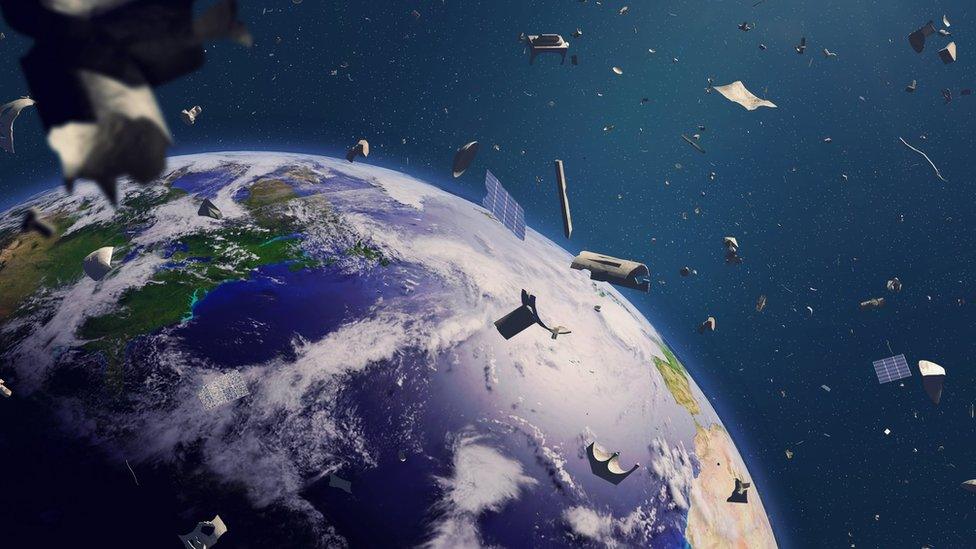Space junk: What is it and why is it a problem?
- Published
- comments

Humans have been sending probes, people and satellites into space since the 1950s, but a lot of junk has been left behind.
Orbiting around our planet are bits of rockets, dead satellites, even tools that astronauts have dropped over the years.
So, as space travel happens more often and we continue to explore our solar system, the space around our planet is getting messier.
What is space junk?
Jenny explains what space junk is and why it's causing problems
Space junk is any human made stuff that has been left behind. Most of it is floating around the planet, but some equipment was also left on the Moon during the 60s and 70s.
It includes big objects like discarded rockets, pieces of machinery and old satellites that have failed or aren't in use any more.
But it can also mean objects that are much, much smaller like flecks of paint that have fallen off spaceships.
How much space junk is there?
There are more than 30,000 pieces of space junk bigger than 10 centimetres in orbit around the Earth and that number goes into millions when you count all the tiny pieces floating about too. It's estimated that there are 128 million pieces of debris smaller than 1cm.
And while there are about 2,000 active satellites orbiting Earth at the moment, there are also 3,000 inactive ones.
So why is it a problem?
More space junk means more problems. The bigger the space junk, the bigger problems it can cause.
Most of the objects pose very little threat to us here on Earth because a lot of chunks of space rubbish would just burn up and disappear if they ever entered the atmosphere.
However, the problems start in space. There's a risk of space debris crashing into important satellites, which provide vital services like map GPS and weather warnings.
Even small bits of junk are travelling in orbit at a speed of five miles per second, meaning any collision can cause a lot of damage.
Every year, hundreds of collision avoidance manoeuvres are made by satellites and even by the International Space Station (ISS), where astronauts live and work.
We're tracking over 26000 objects, ranging in size from a smart phone to the space station. Maybe 35000 are working satellites, things that have some purpose, but everything else is rubbish.
A piece of space junk was seen close to the SpaceX Dragon capsule as it prepared to dock with the ISS this week.
The four astronauts inside the capsule also heard an alarm, warning of a potential collision.
The astronauts were told to put on their spacesuits because of the possible impact last Friday but later it turned out to be a false alarm.
Lieutenant Colonel Erin Dick, a spokeswoman for Space Command, said it was a system "reporting error", and that there was "no threat" to the crew.
Watching rubbish
Large unused rocket bodies have the potential to break into thousands of pieces.
There are concerns that eventually more and more space objects will collide creating new space junk, making Earth's orbit more difficult to navigate or travel through.
Prof Moriba Jah and his colleagues built AstriaGraph - a near real-time map of where each object is located in space around the Earth.
"We're tracking over 26000 objects, ranging in size from a smart phone to the space station. Maybe 35000 are working satellites, things that have some purpose, but everything else is rubbish," said Prof Moriba Jah.
"Large rocket bodies that have been up there for decades, at some point they will either explode, or something will hit them and they will become many tens of thousands of pieces."
Litter picking in space
Companies are looking at ways of collecting space junk and getting rid of it
With companies such as SpaceX and Amazon sending more satellites into orbit, the space around the planet is getting even more crowded.
The United Nations says all companies should remove their satellites from orbit within 25 years after the end of their mission.
So now companies and spaces agencies are looking at ways to clear up the litter left behind.
They include devices that can catch satellites and pull them back down to burn up in the atmosphere. Lasers to knock objects out of orbit and big magnets or claws that can grab the pieces of junk.
Prof Moriba Jah wonders whether countries investing money into space travel will also spend money on clearing the junk left behind.
"Given all the other problems facing humanity - Will those countries spend resources to remove these big rocket bodies?" He said.
- Published20 March 2021
- Published18 November 2020
- Published19 January 2021
